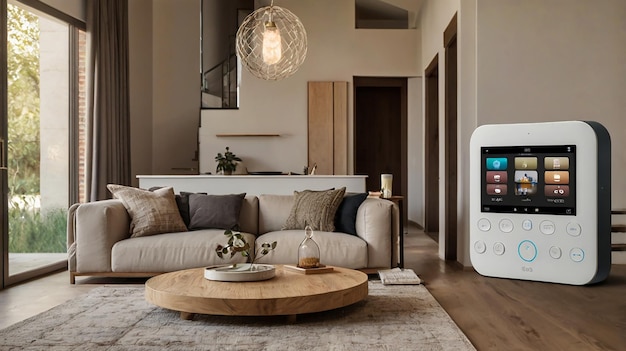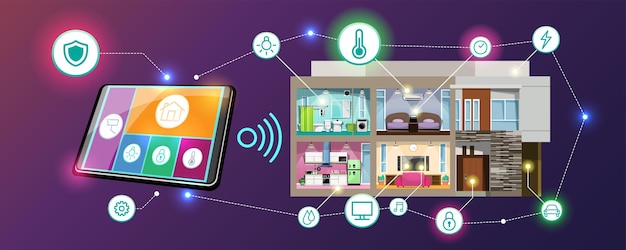Smart Homes: Latest Tech & Trends for US Consumers

Smart homes in the US are evolving with innovations like enhanced security systems, energy-efficient appliances, and seamless integration with AI assistants, offering consumers greater convenience and control.
Do you dream of a home that anticipates your needs, maximizes energy efficiency, and keeps your family safe? The rise of smart homes: the latest trends and technologies for US consumers is making this dream a reality. Let’s explore the innovative world of connected living and discover the top trends transforming homes across the nation.
Understanding Smart Home Technology
Smart home technology refers to devices and systems that are connected to the internet and can be controlled remotely. This connectivity allows homeowners to automate tasks, monitor their homes, and optimize energy consumption.
From smart thermostats and lighting to security systems and entertainment devices, the possibilities for creating a connected home are vast. Let’s delve into the core components that make up a smart home ecosystem.
Key Components of a Smart Home
At the heart of every smart home is a network that connects all the different devices. This network allows the devices to communicate with each other and with the homeowner through a central control system.
Understanding these core components can help you better plan your smart home setup:
- Smart Hub: A central device that connects and controls all smart home devices.
- Smart Devices: Individual appliances and gadgets with built-in connectivity.
- Mobile App: An interface that allows users to remotely monitor and control their smart home.
Advancements in connectivity protocols and device interoperability continue to improve the user experience, making it easier than ever to create a truly integrated system.

Top Smart Home Trends in the US
The US smart home market is driven by consumer demand for convenience, security, and energy efficiency. Several key trends are shaping the development and adoption of smart home technologies.
Staying informed about these trends ensures you can make the best choices for your home:
Energy Efficiency and Sustainability
With growing environmental awareness, many homeowners are seeking smart home solutions that help them reduce energy consumption. Smart thermostats, lighting systems, and appliances are designed to optimize energy use based on real-time conditions and user preferences.
For example, smart thermostats can learn your daily routines and automatically adjust the temperature to save energy when you are away. Smart lighting systems can dim or turn off lights in unoccupied rooms, further reducing energy waste. Here are some ideas:
- Smart thermostats can automate temperature adjustments.
- Smart lighting systems offer dimming and scheduling options.
- Smart plugs monitor energy consumption of individual devices.
These trends not only benefit the environment but also help homeowners save money on their utility bills. The focus on sustainability is expected to drive further innovations in energy-efficient smart home technologies.
Enhancing Home Security with Smart Technology
Smart home security systems offer advanced features that provide homeowners with peace of mind. These systems include smart locks, security cameras, motion detectors, and alarm systems that can be monitored remotely.
The ability to receive real-time alerts and monitor your home from anywhere is a major draw for many consumers:
Advanced Security Systems
Traditional security systems are being replaced with smart alternatives that offer greater flexibility and control. Smart locks can be operated remotely, allowing you to grant access to visitors or service providers even when you are not home. Security cameras provide live video feeds and can be set to record when motion is detected.
Integrating these systems with professional monitoring services can ensure a rapid response in the event of a break-in or other emergency:
- Smart locks allow remote access and monitoring.
- Security cameras provide live video feeds and alerts.
- Motion detectors send notifications of suspicious activity.
With the rise of sophisticated cyber threats, it’s important for homeowners to prioritize the security of their smart home networks. Strong passwords, regular software updates, and secure network configurations are essential for protecting your connected devices and personal information.

Voice Assistants and Smart Home Integration
Voice assistants like Amazon Alexa, Google Assistant, and Apple HomeKit have become integral to the smart home experience. These AI-powered assistants allow homeowners to control their devices with voice commands, making it easier than ever to manage their homes.
The integration of voice assistants is streamlining the smart home experience:
Seamless Home Automation
Voice assistants can be used to control a wide range of smart home devices, from lights and thermostats to entertainment systems and security cameras. Simply speaking a command, such as “Alexa, turn on the living room lights,” can trigger a series of actions across multiple devices.
This seamless integration simplifies daily routines and enhances the overall convenience of smart home living. Here’s what AI brings to the table:
- Voice control simplifies device management.
- Routine automation streamlines daily tasks.
- Personalized experiences adapt to user preferences.
As voice assistants continue to evolve, they are becoming more intelligent and capable of handling complex requests. This trend is driving greater adoption of smart home technologies and creating new opportunities for innovation.
Entertainment and Connectivity
Smart home technology is transforming the way we consume entertainment. From smart TVs and speakers to streaming devices and gaming consoles, connected devices are enhancing the home entertainment experience.
Here are new features:
Enhanced Entertainment Experiences
Smart TVs offer access to a wide range of streaming services and can be controlled with voice commands. Smart speakers provide high-quality audio and can be used to stream music, podcasts, and audiobooks. Integrating these devices into a smart home ecosystem allows for seamless control and customized entertainment experiences.
For example, you can create a multi-room audio system that plays your favorite music throughout the house or set up a home theater system with automated lighting and sound settings:
- Smart TVs offer access to streaming services.
- Smart speakers provide high-quality audio.
- Automated entertainment settings enhance the user experience.
Innovations in connectivity protocols, such as Wi-Fi 6 and 5G, are improving the speed and reliability of home networks, enabling smoother streaming and lower latency for gaming.
The Future of Smart Homes
The smart home market is poised for continued growth in the coming years, driven by technological advancements and increasing consumer adoption. Several emerging trends are expected to shape the future of smart homes.
Here’s a look into what’s next for the smart home landscape:
Emerging Smart Home Innovations
Artificial intelligence (AI) and machine learning (ML) are playing an increasingly important role in smart home technology. AI-powered systems can learn from user behavior and automatically adjust settings to optimize comfort, energy efficiency, and security. Predictive maintenance capabilities can alert homeowners to potential problems with their appliances before they occur.
Here’s what to expect:
- AI-powered automation adapts to user behavior.
- Predictive maintenance alerts homeowners to potential problems.
- Improved interoperability enhances device compatibility.
As technology continues to evolve, smart homes are becoming more intelligent, intuitive, and integrated. The future of smart home living promises to be more seamless, efficient, and personalized than ever before.
| Key Point | Brief Description |
|---|---|
| 💡 Energy Efficiency | Smart devices optimize energy use with automated adjustments. |
| 🔒 Home Security | Remote monitoring and real-time alerts through smart systems. |
| 🗣️ Voice Assistants | Hands-free control of devices and home automation. |
| 🎵 Entertainment | Enhanced media experiences with smart TVs and speakers. |
Frequently Asked Questions
▼
A smart home integrates devices connected to the internet, automating tasks and allowing remote monitoring and control for enhanced convenience and efficiency.
▼
Smart thermostats, lighting, & appliances monitor and adjust settings based on usage patterns, optimizing energy conservation and reducing utility costs.
▼
Security varies; prioritize devices with robust encryption. Regularly update software and use strong, unique passwords for each device to enhance security.
▼
Popular choices include Amazon Alexa, Google Assistant, and Apple HomeKit. The best option depends on your existing devices and ecosystem preferences.
▼
Smart security systems offer remote monitoring, real-time alerts, and automated responses, enabling enhanced peace of mind and faster response times to emergencies.
Conclusion
As technology continues to advance, smart homes are set to become even more integrated, intelligent, and indispensable. From enhancing home security to optimizing energy efficiency and streamlining entertainment, the benefits of smart home technology are undeniable for US consumers.





